A near-Mir-miss
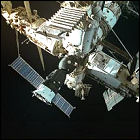 Crew members of space station Mir and Russian ground controllers practice manual remote control of an unmanned Progress supply vehicle near the station. Where most previous Progress spacecraft have automatically docked using the KURS radar system, Russia is now seeking alternatives, as the Ukraine-made KURS hardware is proving too expensive to keep buying for non-reusable vehicles. During Mir Commander Vasily Tsibliev’s attempt to redock Progress M33, the remote control signal is interrupted, leaving the ten-ton Progress barreling toward the station. Fortunately, it narrowly misses Mir, though the remote control issue will resurface more dramatically with the next Progress craft to visit the space station.
Crew members of space station Mir and Russian ground controllers practice manual remote control of an unmanned Progress supply vehicle near the station. Where most previous Progress spacecraft have automatically docked using the KURS radar system, Russia is now seeking alternatives, as the Ukraine-made KURS hardware is proving too expensive to keep buying for non-reusable vehicles. During Mir Commander Vasily Tsibliev’s attempt to redock Progress M33, the remote control signal is interrupted, leaving the ten-ton Progress barreling toward the station. Fortunately, it narrowly misses Mir, though the remote control issue will resurface more dramatically with the next Progress craft to visit the space station.
Mir: Fire on high
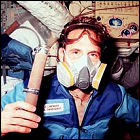 Fire breaks out aboard the Russian space station Mir, forcing the crew to break out face masks and goggles which they must keep on even after the fire is put out. The culprit is determined to be an oxygen generator, which is damaged beyond repair; fortunately, American crewmember Jerry Linenger is a medical doctor and determines that he and his crewmates are none the worse for wear. A new oxygen generator will arrive on the next Space Shuttle mission to Mir later in the year.
Fire breaks out aboard the Russian space station Mir, forcing the crew to break out face masks and goggles which they must keep on even after the fire is put out. The culprit is determined to be an oxygen generator, which is damaged beyond repair; fortunately, American crewmember Jerry Linenger is a medical doctor and determines that he and his crewmates are none the worse for wear. A new oxygen generator will arrive on the next Space Shuttle mission to Mir later in the year.
STS-82: back to Hubble
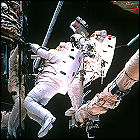 Space Shuttle Discovery lifts off on a ten-day mission to service the Hubble Space Telescope. Over 30 hours of spacewalks are conducted to repair and upgrade Hubble with new parts, and the shuttle engines are fired in short, steady bursts to raise the telescope’s orbit by over eight miles before it is released again. Aboard Discovery on her 22nd flight are Commander Kenneth Bowersox, Pilot Scott Horowitz, and mission specialists Mark Lee, Steven Hawley, Gregory Harbaugh, Steven Smith and Joseph Tanner.
Space Shuttle Discovery lifts off on a ten-day mission to service the Hubble Space Telescope. Over 30 hours of spacewalks are conducted to repair and upgrade Hubble with new parts, and the shuttle engines are fired in short, steady bursts to raise the telescope’s orbit by over eight miles before it is released again. Aboard Discovery on her 22nd flight are Commander Kenneth Bowersox, Pilot Scott Horowitz, and mission specialists Mark Lee, Steven Hawley, Gregory Harbaugh, Steven Smith and Joseph Tanner.
Soyuz TM-25
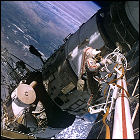 Russian cosmonauts Vasili Tsibliyev and Aleksandr Lazutkin lift off aboard Soyuz TM-25 for an eventful mission aboard Russian space station Mir. Tagging along is German space traveler Reinhold Ewald, who will remain in space for 19 days before returning to Earth with Mir’s previous crew aboard Soyuz TM-24; Tsibliyev and Lazutkin will later be joined by American shuttle astronaut Jerry Linenger. Their 184-day stay is marred by numerous emergencies aboard the station, ranging from a fire in the station’s cramped quarters to a collision with an unmanned Progress cargo spacecraft, which Russian ground controllers are initially eager to keep quiet from the rest of the world.
Russian cosmonauts Vasili Tsibliyev and Aleksandr Lazutkin lift off aboard Soyuz TM-25 for an eventful mission aboard Russian space station Mir. Tagging along is German space traveler Reinhold Ewald, who will remain in space for 19 days before returning to Earth with Mir’s previous crew aboard Soyuz TM-24; Tsibliyev and Lazutkin will later be joined by American shuttle astronaut Jerry Linenger. Their 184-day stay is marred by numerous emergencies aboard the station, ranging from a fire in the station’s cramped quarters to a collision with an unmanned Progress cargo spacecraft, which Russian ground controllers are initially eager to keep quiet from the rest of the world.
STS-81
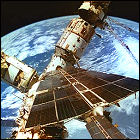 Space Shuttle Atlantis lifts off on the 81st shuttle flight, a ten-day mission featuring the fifth docking between Atlantis and the Mir space station. Atlantis again carries the SPACEHAB module in its cargo bay, and thousands of pounds of consumables and equipment are transferred from the shuttle to Mir. Aboard Atlantis for her 17th flight are Commander Michael Baker, Pilot Brent Jett, and mission specialists John Grunsfeld, Marsha Ivins, Peter Wisoff and Jerry Linenger. Linenger remains on Mir, while American Mir Expedition 22 crewmember John Blaha returns after 128 days in space.
Space Shuttle Atlantis lifts off on the 81st shuttle flight, a ten-day mission featuring the fifth docking between Atlantis and the Mir space station. Atlantis again carries the SPACEHAB module in its cargo bay, and thousands of pounds of consumables and equipment are transferred from the shuttle to Mir. Aboard Atlantis for her 17th flight are Commander Michael Baker, Pilot Brent Jett, and mission specialists John Grunsfeld, Marsha Ivins, Peter Wisoff and Jerry Linenger. Linenger remains on Mir, while American Mir Expedition 22 crewmember John Blaha returns after 128 days in space.
STS-80
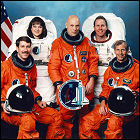 Space Shuttle Columbia lifts off on the 80th shuttle flight, a science mission lasting nearly 18 days. Two free-floating experiment platforms are deployed and then retrieved by the end of the mission for delivery back to Earth. Two spacewalks to test space station construction techniques are called off for safety reasons when a problem arises with Columbia’s airlock. Aboard Columbia for her 21st flight are Commander Kenneth Cockrell, Pilot Kent Rominger, and mission specialists Tammy Jernigan, Thomas Jones and Story Musgrave.
Space Shuttle Columbia lifts off on the 80th shuttle flight, a science mission lasting nearly 18 days. Two free-floating experiment platforms are deployed and then retrieved by the end of the mission for delivery back to Earth. Two spacewalks to test space station construction techniques are called off for safety reasons when a problem arises with Columbia’s airlock. Aboard Columbia for her 21st flight are Commander Kenneth Cockrell, Pilot Kent Rominger, and mission specialists Tammy Jernigan, Thomas Jones and Story Musgrave.
STS-79: fourth Shuttle-Mir mission
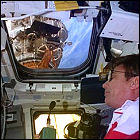 After multiple delays, including the entire launch stack having to be rolled back into the safety of the Vehicle Assembly Building to protect it from two back-to-back hurricanes, Space Shuttle Atlantis lifts off on the fourth mission to dock with the Russian Mir space station. Supplies are transferred to Mir, and numerous completed science experiments from Mir are loaded into the shuttle. Atlantis is flown by Commander William Readdy, Pilot Terrence Wilcutt, and mission specialists Thomas Akers, John Blaha, Jay Apt and Carl Walz. Blaha remains on Mir, taking the place of American astronaut Shannon Lucid, who has just set a new American space endurance record of 188 days in orbit; Lucid returns to Earth with the Atlantis crew.
After multiple delays, including the entire launch stack having to be rolled back into the safety of the Vehicle Assembly Building to protect it from two back-to-back hurricanes, Space Shuttle Atlantis lifts off on the fourth mission to dock with the Russian Mir space station. Supplies are transferred to Mir, and numerous completed science experiments from Mir are loaded into the shuttle. Atlantis is flown by Commander William Readdy, Pilot Terrence Wilcutt, and mission specialists Thomas Akers, John Blaha, Jay Apt and Carl Walz. Blaha remains on Mir, taking the place of American astronaut Shannon Lucid, who has just set a new American space endurance record of 188 days in orbit; Lucid returns to Earth with the Atlantis crew.
Soyuz TM-24
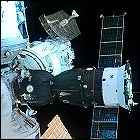 Soyuz TM-24 is launched from Russia, on a mission to dock with the Mir space station. Aboard are cosmonauts Valery Korzun and Aleksandr Kaleri, who stay aboard Mir for 196 days, and visiting French spationaut Claudie André-Deshays, the first French woman in space, who stays aboard Mir for 16 days before returning to Earth with the station’s previous crew aboard Soyuz TM-23. Korzun and Kaleri will return to Earth in March 1997.
Soyuz TM-24 is launched from Russia, on a mission to dock with the Mir space station. Aboard are cosmonauts Valery Korzun and Aleksandr Kaleri, who stay aboard Mir for 196 days, and visiting French spationaut Claudie André-Deshays, the first French woman in space, who stays aboard Mir for 16 days before returning to Earth with the station’s previous crew aboard Soyuz TM-23. Korzun and Kaleri will return to Earth in March 1997.
STS-78
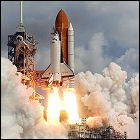 Space Shuttle Columbia lifts off on the 78th shuttle mission, a Spacelab flight lasting nearly 17 days and devoted to the effects of microgravity on various forms of life. The crew also tests maneuvers under consideration for a future Hubble Space Telescope servicing mission which could safely boost Hubble’s orbit without damaging it. Aboard Columbia for her 20th flight are Commander Terence Henricks, Pilot Kevin Kregel, flight engineer Susan Helms, mission specialists Richard Linnehan and Charles Brady, and payload specialists Jean-Jacques Favier and Robert Thirsk.
Space Shuttle Columbia lifts off on the 78th shuttle mission, a Spacelab flight lasting nearly 17 days and devoted to the effects of microgravity on various forms of life. The crew also tests maneuvers under consideration for a future Hubble Space Telescope servicing mission which could safely boost Hubble’s orbit without damaging it. Aboard Columbia for her 20th flight are Commander Terence Henricks, Pilot Kevin Kregel, flight engineer Susan Helms, mission specialists Richard Linnehan and Charles Brady, and payload specialists Jean-Jacques Favier and Robert Thirsk.
STS-77
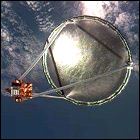 Space Shuttle Endeavour lifts off on the 77th shuttle mission, a ten-day flight to perform experiments in the cargo-bay-mounted SPACEHAB module, and a test of a free-flying inflatible antenna system. The crew also communicates with astronaut Shannon Lucid aboard Mir, though Endeavour and Mir are in different orbits. Aboard Endeavour for her 11th flight are Commander John Casper, Pilot Curtis Brown, and mission specialists Daniel Bursch, Mario Runco, Marc Garneau and Andrew Thomas.
Space Shuttle Endeavour lifts off on the 77th shuttle mission, a ten-day flight to perform experiments in the cargo-bay-mounted SPACEHAB module, and a test of a free-flying inflatible antenna system. The crew also communicates with astronaut Shannon Lucid aboard Mir, though Endeavour and Mir are in different orbits. Aboard Endeavour for her 11th flight are Commander John Casper, Pilot Curtis Brown, and mission specialists Daniel Bursch, Mario Runco, Marc Garneau and Andrew Thomas.
STS-76: third Shuttle-Mir docking
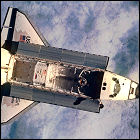 Space Shuttle Atlantis lifts off on the 76th shuttle mission, a flight to dock with the Russian space station Mir. Supplies are delivered to Mir by the Atlantis crew, and astronaut Shannon Lucid remains aboard Mir to join its Expedition 21 crew. Atlantis also carries the SPACEHAB module, where both the shuttle and station crews conduct joint scientific experiments. Aboard Atlantis for her 16th flight are Commander Kevin Chilton, Pilot Richard Searfoss, and mission specialists Shannon Lucid, Linda Godwin, Michael Clifford and Ronald Sega.
Space Shuttle Atlantis lifts off on the 76th shuttle mission, a flight to dock with the Russian space station Mir. Supplies are delivered to Mir by the Atlantis crew, and astronaut Shannon Lucid remains aboard Mir to join its Expedition 21 crew. Atlantis also carries the SPACEHAB module, where both the shuttle and station crews conduct joint scientific experiments. Aboard Atlantis for her 16th flight are Commander Kevin Chilton, Pilot Richard Searfoss, and mission specialists Shannon Lucid, Linda Godwin, Michael Clifford and Ronald Sega.
STS-75
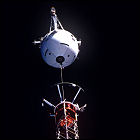 Space Shuttle Columbia is launched on the 75th shuttle flight, staying in orbit for nearly 16 days. The crew attempts to deploy a tethered satellite experiment flown unsuccessfully in 1992, only to watch as the tether snaps with the satellite 12 miles away from the shuttle. The remainder of the flight is spent conducting planned material science experiments. Aboard Columbia for her 19th flight are Commander Andrew Allen, Pilot Scott Horowitz, Payload Commander Franklin Chang-Diaz, and mission specialists Maurizio Cheli, Jeffrey Hoffman, Claude Nicollier and Umberto Guidoni. To this day, video of the satellite floating in space after the tether failure is circulated as “proof” of the existence of UFOs.
Space Shuttle Columbia is launched on the 75th shuttle flight, staying in orbit for nearly 16 days. The crew attempts to deploy a tethered satellite experiment flown unsuccessfully in 1992, only to watch as the tether snaps with the satellite 12 miles away from the shuttle. The remainder of the flight is spent conducting planned material science experiments. Aboard Columbia for her 19th flight are Commander Andrew Allen, Pilot Scott Horowitz, Payload Commander Franklin Chang-Diaz, and mission specialists Maurizio Cheli, Jeffrey Hoffman, Claude Nicollier and Umberto Guidoni. To this day, video of the satellite floating in space after the tether failure is circulated as “proof” of the existence of UFOs.
Soyuz TM-23
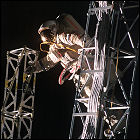 Russia launches the Soyuz TM-23 mission to the Mir space station. The crew, cosmonauts Yuri Onufrienko and Yury Usachov, remain aboard Mir for 193 days, returning to Earth in September 1996 with French spationaut Claudie André-Deshays.
Russia launches the Soyuz TM-23 mission to the Mir space station. The crew, cosmonauts Yuri Onufrienko and Yury Usachov, remain aboard Mir for 193 days, returning to Earth in September 1996 with French spationaut Claudie André-Deshays.
STS-72
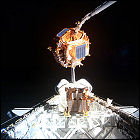 Space Shuttle Endeavour lifts off on the 74th flight of the shuttle program. Over nine days, Endeavour’s crew retrieves a Japanese satellite for return to Earth while deploying a NASA experiment which flies as far as 45 miles away from the shuttle for two days before it, too, is retrieved. More spacewalk techniques and technologies are tried out for future space station construction. Aboard Endeavour for her tenth flight are Commander Brian Duffy, Pilot Brent Jett, and mission specialists Leroy Chiao, Daniel Barry, Winston Scott and Koichi Wakata.
Space Shuttle Endeavour lifts off on the 74th flight of the shuttle program. Over nine days, Endeavour’s crew retrieves a Japanese satellite for return to Earth while deploying a NASA experiment which flies as far as 45 miles away from the shuttle for two days before it, too, is retrieved. More spacewalk techniques and technologies are tried out for future space station construction. Aboard Endeavour for her tenth flight are Commander Brian Duffy, Pilot Brent Jett, and mission specialists Leroy Chiao, Daniel Barry, Winston Scott and Koichi Wakata.
STS-74: Atlantis returns to Mir
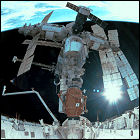 NASA launches Space Shuttle Atlantis on the 73rd shuttle flight, an eight-day mission to dock with Russian space station Mir. Due to the docking difficulties of the first flight – which required Mir crew members to move one of their station’s modules out of the shuttle’s way temporarily – Atlantis carries a Russian-made docking adapter which adds a tunnel to one of Mir’s docking ports, allowing the shuttle to join up with the station without further module relocation. Atlantis carries Commander Kenneth Cameron, Pilot James Halsell, and mission specialists Jerry Ross, William McArthur and Chris Hadfield to visit Mir; there is no crew exchange on this flight.
NASA launches Space Shuttle Atlantis on the 73rd shuttle flight, an eight-day mission to dock with Russian space station Mir. Due to the docking difficulties of the first flight – which required Mir crew members to move one of their station’s modules out of the shuttle’s way temporarily – Atlantis carries a Russian-made docking adapter which adds a tunnel to one of Mir’s docking ports, allowing the shuttle to join up with the station without further module relocation. Atlantis carries Commander Kenneth Cameron, Pilot James Halsell, and mission specialists Jerry Ross, William McArthur and Chris Hadfield to visit Mir; there is no crew exchange on this flight.
STS-73
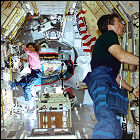 Space Shuttle Columbia is launched on the 72nd shuttle mission, and Columbia’s 18th visit to Earth orbit. Over a 16-day period, the Spacelab module mounted in the cargo bay hosts the second U.S. Microgravity Laboratory mission, with experiments conducted around the clock. The first pitch of the fifth game of the 1995 World Series is thrown aboard Columbia and broadcast live – the first time that the first pitch of a game took place somewhere other than the ballpark in question. Columbia is manned by Commander Kenneth Bowersox, Pilot Kent Rominger, Payload Commander Kathryn Thornton, mission specialists Catherine Coleman and Michael Lopez-Alegria, and payload specialists Fred Leslie and Albert Sacco.
Space Shuttle Columbia is launched on the 72nd shuttle mission, and Columbia’s 18th visit to Earth orbit. Over a 16-day period, the Spacelab module mounted in the cargo bay hosts the second U.S. Microgravity Laboratory mission, with experiments conducted around the clock. The first pitch of the fifth game of the 1995 World Series is thrown aboard Columbia and broadcast live – the first time that the first pitch of a game took place somewhere other than the ballpark in question. Columbia is manned by Commander Kenneth Bowersox, Pilot Kent Rominger, Payload Commander Kathryn Thornton, mission specialists Catherine Coleman and Michael Lopez-Alegria, and payload specialists Fred Leslie and Albert Sacco.
STS-69
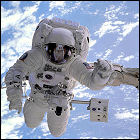 Space Shuttle Endeavour lifts off on the 71st shuttle flight, an 11-day mission to conduct solar wind experiments and test out new spacewalking techniques and space suit revisions for future construction of the International Space Station. Aboard Endeavour for her ninth flight are Commander David Walker, Pilot Kenneth Cockrell, Payload Commander James Voss, and mission specialists James Newman and Michael Gernhardt.
Space Shuttle Endeavour lifts off on the 71st shuttle flight, an 11-day mission to conduct solar wind experiments and test out new spacewalking techniques and space suit revisions for future construction of the International Space Station. Aboard Endeavour for her ninth flight are Commander David Walker, Pilot Kenneth Cockrell, Payload Commander James Voss, and mission specialists James Newman and Michael Gernhardt.
Soyuz TM-22
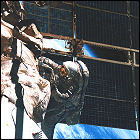 Russia launches the Soyuz TM-22 mission to space station Mir, carrying cosmonauts Yuri Gidzenko and Sergei Avdeyev from Russia, and Thomas Reiter from Germany. The three space travelers settle in for a 179-day stay aboard Mir, from which they will return early in 1996.
Russia launches the Soyuz TM-22 mission to space station Mir, carrying cosmonauts Yuri Gidzenko and Sergei Avdeyev from Russia, and Thomas Reiter from Germany. The three space travelers settle in for a 179-day stay aboard Mir, from which they will return early in 1996.
STS-70
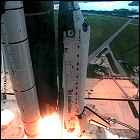 Space Shuttle Discovery lifts off on the 70th shuttle flight, a nine-day mission to deploy a TDRS (Tracking & Data Relay Satellite) for NASA. The flight has seen many delays, including repairs made necessary by woodpeckers poking holes in the shuttle’s external fuel tank! The crew – consisting of Commander Terence Henricks, Pilot Kevin Kregel, and mission specialists Nancy Jane Currie, Donald Thomas and Mary Ellen Weber – conducts material and medical experiments after the deployment of the final satellite in the TDRS constellation.
Space Shuttle Discovery lifts off on the 70th shuttle flight, a nine-day mission to deploy a TDRS (Tracking & Data Relay Satellite) for NASA. The flight has seen many delays, including repairs made necessary by woodpeckers poking holes in the shuttle’s external fuel tank! The crew – consisting of Commander Terence Henricks, Pilot Kevin Kregel, and mission specialists Nancy Jane Currie, Donald Thomas and Mary Ellen Weber – conducts material and medical experiments after the deployment of the final satellite in the TDRS constellation.
STS-71: the shuttle docks at Mir
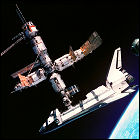 Space Shuttle Atlantis lifts off on an almost-ten-day mission to dock with the Russian space station Mir. The first docking proves to be a chore, as the Mir crew has to move one of the station’s modules to a different docking port to accomodate the shuttle. The historic docking – the first joint operation between the two countries since the Apollo-Soyuz mission almost exactly 20 years earlier – results in the largest man-made object in space to date. Aboard Atlantis are Commander Robert Gibson, Pilot Charles Precourt, and mission specialists Ellen Baker, Bonnie Dunbar and Gregory Harbaugh; cosmonauts Anatoly Solovyev and Nikolai Budarin are transported to Mir aboard Atlantis to become part of Mir Expedition 19, while Expedition 18 crew members Norman Thagard, Vladimir Dezhurov and Gannady Strekalov return to Earth after more than three months aboard Mir.
Space Shuttle Atlantis lifts off on an almost-ten-day mission to dock with the Russian space station Mir. The first docking proves to be a chore, as the Mir crew has to move one of the station’s modules to a different docking port to accomodate the shuttle. The historic docking – the first joint operation between the two countries since the Apollo-Soyuz mission almost exactly 20 years earlier – results in the largest man-made object in space to date. Aboard Atlantis are Commander Robert Gibson, Pilot Charles Precourt, and mission specialists Ellen Baker, Bonnie Dunbar and Gregory Harbaugh; cosmonauts Anatoly Solovyev and Nikolai Budarin are transported to Mir aboard Atlantis to become part of Mir Expedition 19, while Expedition 18 crew members Norman Thagard, Vladimir Dezhurov and Gannady Strekalov return to Earth after more than three months aboard Mir.
Spektr: expanding Mir anew
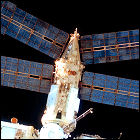 For the first time in five years, and the first time under the auspices of the Russian Federation, a new module is launched to expand the Mir space station. Originally devised as an add-on compartment to house experiments and equipment of a military nature, the Spektr module is, somewhat ironically, refitted to house American astronauts who will be joining future Mir station crews. Spektr also doubles Mir’s power generating capacity with its own solar panels.
For the first time in five years, and the first time under the auspices of the Russian Federation, a new module is launched to expand the Mir space station. Originally devised as an add-on compartment to house experiments and equipment of a military nature, the Spektr module is, somewhat ironically, refitted to house American astronauts who will be joining future Mir station crews. Spektr also doubles Mir’s power generating capacity with its own solar panels.
Soyuz TM-21
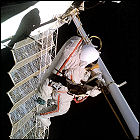 An American astronaut lifts off aboard a Russian Soyuz spacecraft for the first time ever with the launch of Soyuz TM-21, a mission to the Mir space station. Cosmonauts Vladimir Dezhurov and Gennady Strekalov are joined by astronaut Norman Thagard aboard Mir, where they remain for 115 days. During that time, they witness the arrival of the Spektr module, a new addition to the station, and they ultimately return to Earth aboard space shuttle Atlantis in July 1995; Soyuz TM-21 remains at the station, where a future Mir crew uses it to return to Earth. During the Atlantis mission, a new record is set for the number of humans in space, as the station and shuttle crews add up to 13 people in orbit at once.
An American astronaut lifts off aboard a Russian Soyuz spacecraft for the first time ever with the launch of Soyuz TM-21, a mission to the Mir space station. Cosmonauts Vladimir Dezhurov and Gennady Strekalov are joined by astronaut Norman Thagard aboard Mir, where they remain for 115 days. During that time, they witness the arrival of the Spektr module, a new addition to the station, and they ultimately return to Earth aboard space shuttle Atlantis in July 1995; Soyuz TM-21 remains at the station, where a future Mir crew uses it to return to Earth. During the Atlantis mission, a new record is set for the number of humans in space, as the station and shuttle crews add up to 13 people in orbit at once.
STS-67
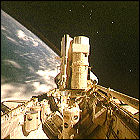 NASA launches Space Shuttle Endeavour on the longest flight of the shuttle program to date – over 16 and a half days – with the ASTRO astronomy experiment package mounted in the cargo bay. Some astronomical observations on this mission are conducted in tandem with the Hubble Space Telescope. Aboard Endeavour for her eighth flight are Commander Stephen Oswald, Pilot William Gregory, Payload Commander Tammy Jernigan, mission specialists John Grunsfeld and Wendy Lawrence, and payload specialists Ronald Parise and Samuel Durrance.
NASA launches Space Shuttle Endeavour on the longest flight of the shuttle program to date – over 16 and a half days – with the ASTRO astronomy experiment package mounted in the cargo bay. Some astronomical observations on this mission are conducted in tandem with the Hubble Space Telescope. Aboard Endeavour for her eighth flight are Commander Stephen Oswald, Pilot William Gregory, Payload Commander Tammy Jernigan, mission specialists John Grunsfeld and Wendy Lawrence, and payload specialists Ronald Parise and Samuel Durrance.
STS-63: the shuttle visits Mir
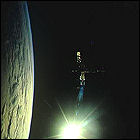 Space Shuttle Discovery lifts off on the 67th flight of the shuttle program, a history-making mission that sees Discovery conducting rendezvous maneuvers at the Russian space station Mir. Though the shuttle isn’t equipped to dock at Mir, the close flyby is a necessary step before a docking mission can take place, and Discovery’s crew includes a former Mir cosmonaut. The crew for this flight is Commander James Wetherbee, Pilot Eileen M. Collins, and mission Specialists Michael Foale, Janice Voss, Bernard Harris and Vladimar Titov.
Space Shuttle Discovery lifts off on the 67th flight of the shuttle program, a history-making mission that sees Discovery conducting rendezvous maneuvers at the Russian space station Mir. Though the shuttle isn’t equipped to dock at Mir, the close flyby is a necessary step before a docking mission can take place, and Discovery’s crew includes a former Mir cosmonaut. The crew for this flight is Commander James Wetherbee, Pilot Eileen M. Collins, and mission Specialists Michael Foale, Janice Voss, Bernard Harris and Vladimar Titov.
STS-66
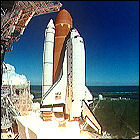 Space Shuttle Atlantis lifts off on its first flight in two years, an 11-day mission to conduct studies of Earth’s atmosphere with the ATLAS package mounted in the cargo bay. Aboard Atlantis for her 13th flight are Commander Donald McMonagle, Pilot Curtis Brown, Payload Commander Ellen Ochoa, and mission specialists Scott Parazynski, Joseph Tanner and Jean-Francois Clervoy.
Space Shuttle Atlantis lifts off on its first flight in two years, an 11-day mission to conduct studies of Earth’s atmosphere with the ATLAS package mounted in the cargo bay. Aboard Atlantis for her 13th flight are Commander Donald McMonagle, Pilot Curtis Brown, Payload Commander Ellen Ochoa, and mission specialists Scott Parazynski, Joseph Tanner and Jean-Francois Clervoy.
Soyuz TM-20
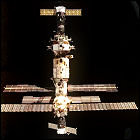 Russia launches the Soyuz TM-20 mission to space station Mir, carrying cosmonauts Alexander Viktorenko and Yelena Kondakova, and German astronaut Ulf Merbold, who will remain for only a month to conduct experiments in orbit. A glitch in the automated docking system forces Viktorenko to assume manual control for the docking with Mir, a problem which will plague future Mir crews. Viktorenko and Kondakova remain aboard Mir for 169 days, returning to Earth in March 1995 with the new space endurance world record holder, Dr. Valery Polyakov, who has spent 437 days in orbit.
Russia launches the Soyuz TM-20 mission to space station Mir, carrying cosmonauts Alexander Viktorenko and Yelena Kondakova, and German astronaut Ulf Merbold, who will remain for only a month to conduct experiments in orbit. A glitch in the automated docking system forces Viktorenko to assume manual control for the docking with Mir, a problem which will plague future Mir crews. Viktorenko and Kondakova remain aboard Mir for 169 days, returning to Earth in March 1995 with the new space endurance world record holder, Dr. Valery Polyakov, who has spent 437 days in orbit.
STS-68
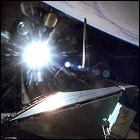 Space Shuttle Endeavour lifts off on the shuttle program’s 65th mission. The eleven-day flight is a second round of space radar experiments, using a cargo-bay-mounted radar system that flew earlier in 1994 aboard Endeavour. The crew for this flight consists of Commander Michael Baker, Pilot Terrence Wilcutt, Payload Commander Thomas Jones, and mission specialists Steven Smith, Daniel Bursch and Peter Wisoff.
Space Shuttle Endeavour lifts off on the shuttle program’s 65th mission. The eleven-day flight is a second round of space radar experiments, using a cargo-bay-mounted radar system that flew earlier in 1994 aboard Endeavour. The crew for this flight consists of Commander Michael Baker, Pilot Terrence Wilcutt, Payload Commander Thomas Jones, and mission specialists Steven Smith, Daniel Bursch and Peter Wisoff.
STS-64
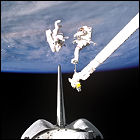 NASA launches Space Shuttle Discovery on the 64th flight of the shuttle program. The cargo bay carries an experiment to test LIDAR applications from orbit, and is the site of a six-hour spacewalk to test an alternative to the retired MMU “jet pack” for EVA rescue purposes. Aboard Discovery for her 19th mission are Commander Richard Richards, Pilot Blaine Hammond, and mission specialists Jerry Linenger, Susan Helms, Carl Meade and Mark Lee.
NASA launches Space Shuttle Discovery on the 64th flight of the shuttle program. The cargo bay carries an experiment to test LIDAR applications from orbit, and is the site of a six-hour spacewalk to test an alternative to the retired MMU “jet pack” for EVA rescue purposes. Aboard Discovery for her 19th mission are Commander Richard Richards, Pilot Blaine Hammond, and mission specialists Jerry Linenger, Susan Helms, Carl Meade and Mark Lee.
STS-65
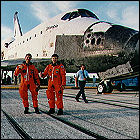 Space Shuttle Columbia is launched on the 63rd mission of the shuttle program. For two weeks, Columbia’s crew participates in the second IML (International Microgravity Laboratory) flight, conducting experiments relying on zero G around the clock. Columbia is also in orbit during the 25th anniversary of Apollo 11, the moon landing mission whose command/service module was also named Columbia. Aboard for Columbia’s 17th flight are Commander Robert Cabana, Pilot James Halsell, Payload Commander Richard Hieb, mission specialists Carl Walz, Leroy Chiao and Donald Thomas, and payload specialist Chiaki Naito-Mukai, the first Japanese woman in space.
Space Shuttle Columbia is launched on the 63rd mission of the shuttle program. For two weeks, Columbia’s crew participates in the second IML (International Microgravity Laboratory) flight, conducting experiments relying on zero G around the clock. Columbia is also in orbit during the 25th anniversary of Apollo 11, the moon landing mission whose command/service module was also named Columbia. Aboard for Columbia’s 17th flight are Commander Robert Cabana, Pilot James Halsell, Payload Commander Richard Hieb, mission specialists Carl Walz, Leroy Chiao and Donald Thomas, and payload specialist Chiaki Naito-Mukai, the first Japanese woman in space.
Deke! U.S. Manned Space From Mercury to the Shuttle
 Forge Books posthumously publishes astronaut Deke Slayton’s non-fictional memoir of his time in NASA, “Deke! U.S. Manned Space From Mercury to the Shuttle“, co-written with Michael Cassutt. The book details Slayton’s selection to the Mercury ground and his subsequent medical grounding, his time in charge of NASA’s astronaut office, and his eventual flight aboard the international Apollo-Soyuz Test Project mission.
Forge Books posthumously publishes astronaut Deke Slayton’s non-fictional memoir of his time in NASA, “Deke! U.S. Manned Space From Mercury to the Shuttle“, co-written with Michael Cassutt. The book details Slayton’s selection to the Mercury ground and his subsequent medical grounding, his time in charge of NASA’s astronaut office, and his eventual flight aboard the international Apollo-Soyuz Test Project mission.